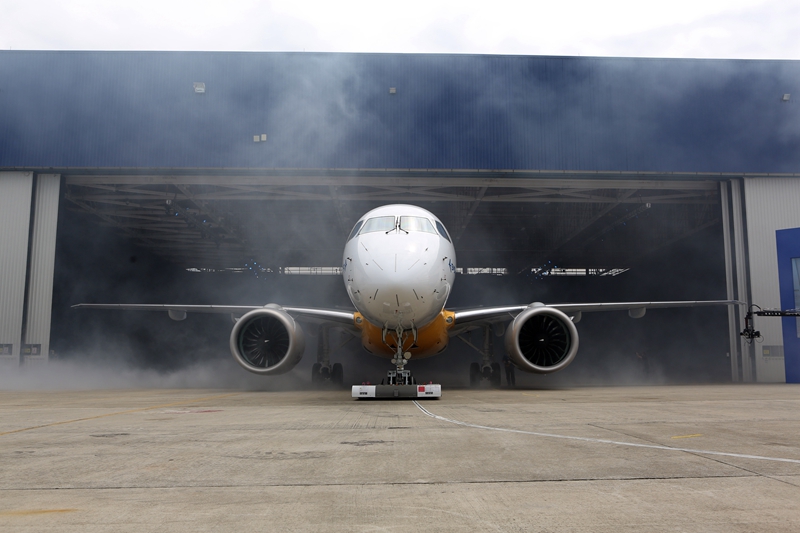 巴西航空工业公司的E190-E2将保留现行版机型的驾驶舱,但将配备新的机翼,以及普惠公司的齿轮传动涡扇发动机。动涡扇发动机。
巴西航空工业公司的E190-E2将保留现行版机型的驾驶舱,但将配备新的机翼,以及普惠公司的齿轮传动涡扇发动机。动涡扇发动机。 巴西航空工业公司在今年2月发布了全新E190-E2喷气式飞机,五月底进行了首次飞行。
巴西航空工业公司在今年2月发布了全新E190-E2喷气式飞机,五月底进行了首次飞行。 巴西航空工业公司的新E2系列喷气式飞机需要面临不少竞争,包括波音公司(Boeing)的737 MAX、空中客车(Airbus)的A320neo及Bombardier公司的C系列。值得注意,后两款机型也同样采用了普惠公司的齿轮传动涡扇发动机。
巴西航空工业公司的新E2系列喷气式飞机需要面临不少竞争,包括波音公司(Boeing)的737 MAX、空中客车(Airbus)的A320neo及Bombardier公司的C系列。值得注意,后两款机型也同样采用了普惠公司的齿轮传动涡扇发动机。
最近,巴西航空工业公司(Embraer)的E190-E2喷气式飞机从巴西São José dos Campos起飞,顺利完成处女航。至此,公司的E-Jets E2项目迈出了重要的一步。今年2月底, E190-E2才刚刚在公司装配厂的发布仪式上与公众首次见面,短短3个月后,就顺利完成首飞。据了解,按照计划这架飞机原定于今年下半年进行首飞,不过由于大量应用了数字建模仿真,并在地面与静力试验中借助了“铁鸟”平台等设备,E2项目的推进速度超出预期。
据了解,E190-E2为巴西航空工业公司3款第二代E-Jet喷气式飞机中的第一款。本次首航标志着E190-E2已经进入认证阶段。按照计划,这款E-Jet机型将于2018年投入商业运营。
本次首航评估了飞机的操作和性能特性,机组人员还分析了大量飞行参数,包括速度、高度以及起落架收起情况等。在首航过程中,机组人员使飞机加速至0.82 Mach,并攀升至41000英尺。
据了解,巴西航空工业公司为了E190-E2的认证程序,共制造了4架原型机,本次进行首航的飞机就是其中1架。此外,公司为预计将于2019年开始服役的E195-E2认证制造了2架原型机,并为预计将于2020年开始服役的E175-E2认证准备了3架原型机。
E-Jets E2采用了与现行版E190相同的平台,但应用了更多先进技术,比如新的先进空气动力学高展弦比机翼、改进的系统与航空电子设备、Moog公司的第四代全飞行线控飞行控制系统,以及普惠公司(Pratt & Whitney)的PurePower GTF发动机(E-175-E2采用了PW1700G发动机,E190-E2和E195-E2则采用了PW1900G)。巴西航空工业公司表示,由于使用了这些技术,新机型的油耗、排放、噪音和维护成本均实现了超过10%的减少,而且由于维护停机时间得到缩短,该机型的生产力也有一定提高。新机型将使用一种通用的架驶舱,搭配霍尼韦尔(Honeywell)的Primus Epic 2航空电子系统,这有助于机组人员顺利过渡至新机型。与传统的窄机身机型相比,E-Jets E2系列喷气式飞机的平均单座成本并没有太大差异,但总体每次航班的成本将有所下降。
E190-E2的座位数量与E190类似,可以通过不同配置调整座位数量,双舱型时为97座,单舱型时为106座。不过,E190-E2的续航里程比E190长400海里,航行高度高达2800海里。
自从2013年6月E-Jets E2上市以来,巴西航空工业公司已经从多家航空公司和租赁公司拿到640架飞机的生产订单:其中,267架为公司订单,另外373架为选择和购买权订单。E-Jets系列是130座以下级别机型的领头羊,全球市场份额超过50%。目前,巴西航空工业公司的E-Jets喷气式飞机正在为来自50个国家的70多家客户服务。
作者:Jean L. Broge
来源:SAE《航空航天工程》杂志
翻译:SAE中国办公室
Embraer's first E190-E2 jet takes off early
Embraer's E-Jets E2 program took an important step forward with the recent completion of the maiden flight of the E190-E2 from its facility in São José dos Campos. The flight occurred just three months after the E190-E2 made its public début at a rollout ceremony at the factory in late February. The flight was originally scheduled not to take place until the second half of this year, though program development of the E2 was expedited by the extensive use of digital modeling simulations and ground and static tests that employed rigs and an iron bird.
The inaugural flight marked the beginning of the certification campaign for the E190-E2, the first of three new second-generation E-Jet models. The E190-E2 is scheduled to enter commercial service in 2018.
The flight entailed the evaluation of aircraft handling and performance characteristics with the crew analyzing a significant number of flight parameters, including speed, altitude, and landing gear retraction. The crew took the aircraft to Mach 0.82 and climbed to 41,000 ft.
The aircraft that flew is the first of four prototypes that will be used in the E190-E2 certification program. Two additional aircraft will be assigned for the E195-E2 certification process that will lead to entry into service in 2019. Three more aircraft will be used to certify the E175-E2, which is scheduled to enter service in 2020.
E-Jets E2s are based on the proven platform of the current-generation E190, but with more advanced technologies applied such as new aerodynamically advanced high-aspect ratio wings, improved systems and avionics, fourth-generation full fly-by-wire flight controls from Moog, and Pratt & Whitney’s PurePower GTF engines (PW1700G on the E175-E2, PW1900G on the E190-E2 and E195-E2). Embraer says those technologies combine to generate double-digit reductions in fuel consumption, emissions, noise, and maintenance costs, as well greater productivity though less scheduled maintenance downtime. What they will share is a common cockpit with Honeywell's Primus Epic 2 avionics system, which will allow for a smooth transition to the new aircraft. E-Jets E2s are expected to achieve similar costs per seat as larger re-engined narrow-body aircraft but with lower costs per trip.
The E190-E2 has the same number of seats as the E190 and can be configured with 97 seats in dual class or 106 seats in a single-class layout. However, it has 400 nmi more range than the E190 and gives operators the ability to fly the aircraft up to 2800 nmi.
Since the E-Jets E2s were launched in June 2013, the program has logged 640 commitments from airlines and leasing companies: 267 are firm orders and 373 are options and purchase rights. The E-Jets family of aircraft is the leader in the up-to-130-seat aircraft category with more than 50% worldwide market share. Embraer E-Jets are currently in service with some 70 customers from 50 countries.
Author: Jean L. Broge
Source: SAE Aerospace Engineering Magazine
等级
打分
- 2分
- 4分
- 6分
- 8分
- 10分
平均分
